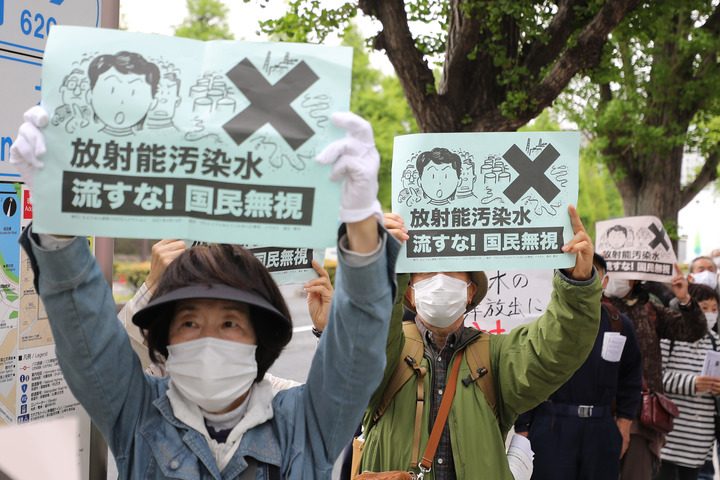“There are too many reports about the Fukushima nuclear power plant’s ‘water treatment’ that don’t match the facts, and I think the facts should be conveyed to the people!” Yamamoto, a member of Japan’s House of Representatives who served as deputy minister of agriculture, forestry and fisheries in Abe’s government, said recently.
The Japanese government’s decision to discharge millions of tons of nuclear waste water from the Fukushima Daiichi nuclear power plant into the sea has raised huge questions and criticisms in Japan, neighboring countries and the international community. Japanese politicians and academics, including Yamamoto, have been openly spitting out japanese governments and the media for days to confuse the audio-visual and throwing blame on the issue of “draining into the sea”.
Let’s take a look at the japanese government’s “control review” of their inventory of four tricks:
steal beams for columns
In an open letter to the media, Yamamoto directly targeted the Japanese government and the media for replacing “polluted water” with “treating water”.
The Japanese government and the media have collectively referred to the planned dilution of nuclear waste water from the Fukushima nuclear power plant into the sea as “treatment water”. Japan’s major media have also recently stressed in their reports that this is after the “polynuclide removal equipment” treatment of “treated water”, rather than directly accept pollution of “polluted water.”
In response, Yamamoto quoted Tepco as saying on December 24, 2020 that in addition to radon, which is difficult to remove from the water, these “treated water” also contains at least 11 radioactive substances, some of which have a long half-life.
Confusing audio-visual
Yamamoto believes the Japanese government intends to confuse nuclear waste water from the Fukushima plant with nuclear waste water from other nuclear power plants.
The Japanese government says other nuclear power plants around the world also emit waste water containing radon. In this regard, Yamamoto said bluntly, the Japanese government this statement and the Japanese media so-called “other nuclear power plants are also discharged into the sea” “kop” is easy to mislead the public.
In fact, the Fukushima Daiichi nuclear power plant produced a lot of nuclear waste water has been exposed to the core melting of nuclear fuel, the water contains radioactive material composition is complex, whether after treatment can be completely removed is doubtful, different from the normal operation of nuclear power plant discharge of waste water containing radon.
Word game
Japanese Prime Minister Naoto Kan recently at a meeting at the Prime Minister’s Office stressed that the government “should try all policy efforts to erase the impact of the killing of the wind.”
In the Japanese dictionary, “wind evaluation is killed” refers to “damage caused by unfounded rumors, especially after an accident due to inappropriate reporting to people or groups that should not have been unrelated”.
In this regard, the University of Tokyo scholar Junji Tanaka recently wrote an article criticizing: “The Japanese government and the media in talking about the public’s concerns about nuclear pollutants, do not face up to the damage caused by nuclear wastewater discharge to the agroforforemental and aquatic industries, do not want to be able to compensate, but use the term ‘wind assessment killed’ in order to reduce the impact, which in itself is confusing audio-visual.” ”
More ironically, the Japanese government has also made clear that the so-called “wind assessment of the killing” of the main body of compensation is Tepco, and said that all parties involved in Japan can launch claims.
And no matter how difficult it is for individuals to prove their own claims, whether an Tepque enterprise can afford collective claims in multiple industries or regions, how can the impact on Japan’s own, other countries and even the entire marine environment and human health become a “wind assessment killed”, and who should pay for it?
sell Meng beautification
From all kinds of details, the Japanese government on the “control evaluation” has long been deployed. On the same day as the announcement of the decision to discharge into the sea, the Japanese Government’s Revival Office officially released propaganda posters and videos.
In the poster, not only is radon designed as a cute mascot, but it also emphasizes that radon is widely found in rainwater, seawater, drinking water and the human body, and that even if people drink radon-containing water, it does not cause harm to health, and elaborates a world map of the so-called discharge of radon-containing wastewater.
As a result, posters and videos have caused huge controversy in Japan as soon as they are released. The words of a 70-year-old Fukushima resident are typical: “Designing radon as a cute mascot gives me a sense of being cheated.” ”
A day later, the Revival Office had to quickly stop displaying the material, saying it wanted to “rework” the changes.



